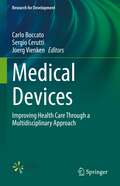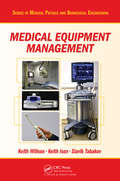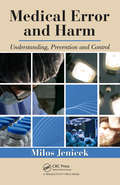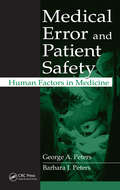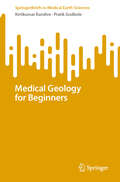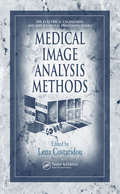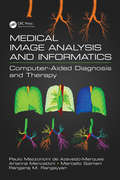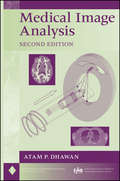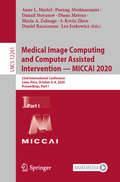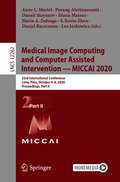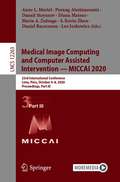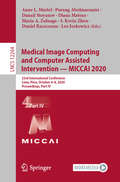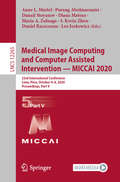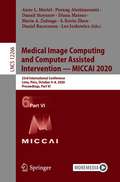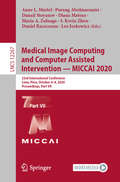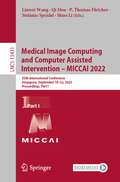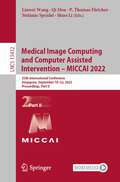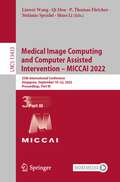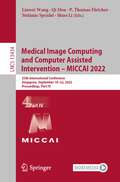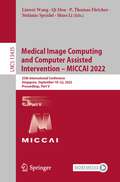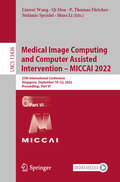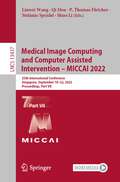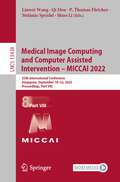- Table View
- List View
Medical Devices: A Practical Guide (Crc Press Focus Shortform Book Program Ser.)
by Prakash Srinivasan Timiri ShanmugamAn overview of the wide variety of medical devices that are an integral part of clinical practice, this practical book includes descriptions of medical devices by both clinical specialty and purpose, thus ensuring that a wide variety of devices are included. Covering important elements such as body contact, duration of contact, the mechanism of each device, its intended use, single and/or multiple use, benefits and any side/adverse/toxicological effects to the patient, and how to avoid user error, and authored by clinicians, researchers and educators who are experienced in medical device use, regulation and research, the content will be of benefit to postgraduate clinicians and employees of medical device companies.
Medical Devices: Improving Health Care Through a Multidisciplinary Approach (Research for Development)
by Sergio Cerutti Carlo Boccato Joerg VienkenThis book provides caregivers and administrators with high-quality support for strategic decision making in the selection and use of medical devices so as to ensure value optimization. Medical treatment is increasingly complex, with wide application of medical devices and corresponding involvement of physics and engineering. A multidisciplinary methodology that brings together expertise from key disciplines in a holistic, system-oriented approach is essential in controlling this complexity and further improving health care. This book will help readers to understand the design, validation, and application of medical devices and the standards and regulations that apply to them across the world. In addition, it provides technical, operational, and economic perspectives on their use. The relevance of concepts such as expenditure optimization and sustainability to medical device technology is explained and healthcare reimbursement systems are discussed from different points of view. Readers will gain a clear appreciation of the managerial and economic implications of the use of medical devices and how to get the most out of them. Academic research, industrial experiences, and case studies are presented as appropriate.
Medical Equipment Management (Series in Medical Physics and Biomedical Engineering)
by Keith Willson Keith Ison Slavik TabakovKnow What to Expect When Managing Medical Equipment and Healthcare Technology in Your OrganizationAs medical technology in clinical care becomes more complex, clinical professionals and support staff must know how to keep patients safe and equipment working in the clinical environment. Accessible to all healthcare professionals and managers, Medica
Medical Error and Harm: Understanding, Prevention, and Control
by Milos JenicekRecent debate over healthcare and its spiraling costs has brought medical error into the spotlight as an indicator of everything that is ineffective, inhumane, and wasteful about modern medicine. But while the tendency is to blame it all on human error, it is a much more complex problem that involves overburdened systems, constantly changing techno
Medical Error and Patient Safety: Human Factors in Medicine
by George A. Peters Barbara J. PetersA difficult and recalcitrant phenomenon, medical error causes pervasive and expensive problems in terms of patient injury, ineffective treatment, and rising healthcare costs. Simple heightened awareness can help, but it requires organized, effective remedies and countermeasures that are reasonable, acceptable, and adaptable to see a truly significa
Medical Geology for Beginners (SpringerBriefs in Medical Earth Sciences)
by Kirtikumar Randive Pratik GodboleThis book is created for a diverse audience that includes geologists and Earth scientists studying the impacts of geological processes on human health, as well as health professionals and medical researchers interested in the environmental determinants of health. It is also a good reference for the environmental scientists and public health policymakers focused on sustainable practices and health risk mitigation. Additionally, undergraduate and postgraduate students, research scholars, and academicians in geosciences, environmental health, and related interdisciplinary fields will find this book valuable for their studies and research. Industry professionals in mining, environmental monitoring, and disaster management will benefit from the health insights provided. Furthermore, individuals working in Ayurveda and traditional medicine will discover valuable information on the therapeutic uses of geological materials. This book explores relationship between geology and human health, providing vital insights for professionals in both the geosciences and health sciences. It delves into how natural processes, materials, and anthropogenic activities influence human health, highlighting the critical role of Medical Geology in modern science and public health. Finally, as Professor Robert Finkleman narrates, &“Medical Geology for Beginners provides an invaluable service to the science of medical geology and to anyone interested in this subject matter and especially to the young readers who may be inspired to pursue a career in medical geology&”.
Medical Image Analysis Methods (Electrical Engineering And Applied Signal Processing Ser.)
by Lena CostaridouTo successfully detect and diagnose disease, it is vital for medical diagnosticians to properly apply the latest medical imaging technologies. It is a worrisome reality that due to either the nature or volume of some of the images provided, early or obscured signs of disease can go undetected or be misdiagnosed. To combat these inaccuracies, diagno
Medical Image Analysis and Informatics: Computer-Aided Diagnosis and Therapy
by Rangaraj M. Rangayyan Paulo Mazzoncini de Azevedo-Marques Arianna Mencattini Marcello SalmeriWith the development of rapidly increasing medical imaging modalities and their applications, the need for computers and computing in image generation, processing, visualization, archival, transmission, modeling, and analysis has grown substantially. Computers are being integrated into almost every medical imaging system. Medical Image Analysis and Informatics demonstrates how quantitative analysis becomes possible by the application of computational procedures to medical images. Furthermore, it shows how quantitative and objective analysis facilitated by medical image informatics, CBIR, and CAD could lead to improved diagnosis by physicians. Whereas CAD has become a part of the clinical workflow in the detection of breast cancer with mammograms, it is not yet established in other applications. CBIR is an alternative and complementary approach for image retrieval based on measures derived from images, which could also facilitate CAD. This book shows how digital image processing techniques can assist in quantitative analysis of medical images, how pattern recognition and classification techniques can facilitate CAD, and how CAD systems can assist in achieving efficient diagnosis, in designing optimal treatment protocols, in analyzing the effects of or response to treatment, and in clinical management of various conditions. The book affirms that medical imaging, medical image analysis, medical image informatics, CBIR, and CAD are proven as well as essential techniques for health care.
Medical Image Analysis, 2nd Edition
by Atam P. DhawanThe expanded and revised edition will split Chapter 4 to include more details and examples in FMRI, DTI, and DWI for MR image modalities. The book will also expand ultrasound imaging to 3-D dynamic contrast ultrasound imaging in a separate chapter. A new chapter on Optical Imaging Modalities elaborating microscopy, confocal microscopy, endoscopy, optical coherent tomography, fluorescence and molecular imaging will be added. Another new chapter on Simultaneous Multi-Modality Medical Imaging including CT-SPECT and CT-PET will also be added. In the image analysis part, chapters on image reconstructions and visualizations will be significantly enhanced to include, respectively, 3-D fast statistical estimation based reconstruction methods, and 3-D image fusion and visualization overlaying multi-modality imaging and information. A new chapter on Computer-Aided Diagnosis and image guided surgery, and surgical and therapeutic intervention will also be added. A companion site containing power point slides, author biography, corrections to the first edition and images from the text can be found here: ftp://ftp.wiley.com/public/sci_tech_med/medical_image/ Send an email to: Pressbooks@ieee.org to obtain a solutions manual. Please include your affiliation in your email.
Medical Image Computing and Computer Assisted Intervention – MICCAI 2020: 23rd International Conference, Lima, Peru, October 4–8, 2020, Proceedings, Part I (Lecture Notes in Computer Science #12261)
by Leo Joskowicz Diana Mateus Maria A. Zuluaga Danail Stoyanov Daniel Racoceanu Purang Abolmaesumi Anne L. Martel S. Kevin ZhouThe seven-volume set LNCS 12261, 12262, 12263, 12264, 12265, 12266, and 12267 constitutes the refereed proceedings of the 23rd International Conference on Medical Image Computing and Computer-Assisted Intervention, MICCAI 2020, held in Lima, Peru, in October 2020. The conference was held virtually due to the COVID-19 pandemic.The 542 revised full papers presented were carefully reviewed and selected from 1809 submissions in a double-blind review process. The papers are organized in the following topical sections: Part I: machine learning methodologies Part II: image reconstruction; prediction and diagnosis; cross-domain methods and reconstruction; domain adaptation; machine learning applications; generative adversarial networks Part III: CAI applications; image registration; instrumentation and surgical phase detection; navigation and visualization; ultrasound imaging; video image analysis Part IV: segmentation; shape models and landmark detection Part V: biological, optical, microscopic imaging; cell segmentation and stain normalization; histopathology image analysis; opthalmology Part VI: angiography and vessel analysis; breast imaging; colonoscopy; dermatology; fetal imaging; heart and lung imaging; musculoskeletal imaging Part VI: brain development and atlases; DWI and tractography; functional brain networks; neuroimaging; positron emission tomography
Medical Image Computing and Computer Assisted Intervention – MICCAI 2020: 23rd International Conference, Lima, Peru, October 4–8, 2020, Proceedings, Part II (Lecture Notes in Computer Science #12262)
by Leo Joskowicz Diana Mateus Maria A. Zuluaga Danail Stoyanov Daniel Racoceanu Purang Abolmaesumi Anne L. Martel S. Kevin ZhouThe seven-volume set LNCS 12261, 12262, 12263, 12264, 12265, 12266, and 12267 constitutes the refereed proceedings of the 23rd International Conference on Medical Image Computing and Computer-Assisted Intervention, MICCAI 2020, held in Lima, Peru, in October 2020. The conference was held virtually due to the COVID-19 pandemic.The 542 revised full papers presented were carefully reviewed and selected from 1809 submissions in a double-blind review process. The papers are organized in the following topical sections: Part I: machine learning methodologies Part II: image reconstruction; prediction and diagnosis; cross-domain methods and reconstruction; domain adaptation; machine learning applications; generative adversarial networks Part III: CAI applications; image registration; instrumentation and surgical phase detection; navigation and visualization; ultrasound imaging; video image analysis Part IV: segmentation; shape models and landmark detection Part V: biological, optical, microscopic imaging; cell segmentation and stain normalization; histopathology image analysis; opthalmology Part VI: angiography and vessel analysis; breast imaging; colonoscopy; dermatology; fetal imaging; heart and lung imaging; musculoskeletal imaging Part VI: brain development and atlases; DWI and tractography; functional brain networks; neuroimaging; positron emission tomography
Medical Image Computing and Computer Assisted Intervention – MICCAI 2020: 23rd International Conference, Lima, Peru, October 4–8, 2020, Proceedings, Part III (Lecture Notes in Computer Science #12263)
by Leo Joskowicz Diana Mateus Maria A. Zuluaga Danail Stoyanov Daniel Racoceanu Purang Abolmaesumi Anne L. Martel S. Kevin ZhouThe seven-volume set LNCS 12261, 12262, 12263, 12264, 12265, 12266, and 12267 constitutes the refereed proceedings of the 23rd International Conference on Medical Image Computing and Computer-Assisted Intervention, MICCAI 2020, held in Lima, Peru, in October 2020. The conference was held virtually due to the COVID-19 pandemic.The 542 revised full papers presented were carefully reviewed and selected from 1809 submissions in a double-blind review process. The papers are organized in the following topical sections: Part I: machine learning methodologies Part II: image reconstruction; prediction and diagnosis; cross-domain methods and reconstruction; domain adaptation; machine learning applications; generative adversarial networks Part III: CAI applications; image registration; instrumentation and surgical phase detection; navigation and visualization; ultrasound imaging; video image analysis Part IV: segmentation; shape models and landmark detection Part V: biological, optical, microscopic imaging; cell segmentation and stain normalization; histopathology image analysis; opthalmology Part VI: angiography and vessel analysis; breast imaging; colonoscopy; dermatology; fetal imaging; heart and lung imaging; musculoskeletal imaging Part VI: brain development and atlases; DWI and tractography; functional brain networks; neuroimaging; positron emission tomography
Medical Image Computing and Computer Assisted Intervention – MICCAI 2020: 23rd International Conference, Lima, Peru, October 4–8, 2020, Proceedings, Part IV (Lecture Notes in Computer Science #12264)
by Leo Joskowicz Diana Mateus Maria A. Zuluaga Danail Stoyanov Daniel Racoceanu Purang Abolmaesumi Anne L. Martel S. Kevin ZhouThe seven-volume set LNCS 12261, 12262, 12263, 12264, 12265, 12266, and 12267 constitutes the refereed proceedings of the 23rd International Conference on Medical Image Computing and Computer-Assisted Intervention, MICCAI 2020, held in Lima, Peru, in October 2020. The conference was held virtually due to the COVID-19 pandemic.The 542 revised full papers presented were carefully reviewed and selected from 1809 submissions in a double-blind review process. The papers are organized in the following topical sections: Part I: machine learning methodologies Part II: image reconstruction; prediction and diagnosis; cross-domain methods and reconstruction; domain adaptation; machine learning applications; generative adversarial networks Part III: CAI applications; image registration; instrumentation and surgical phase detection; navigation and visualization; ultrasound imaging; video image analysis Part IV: segmentation; shape models and landmark detection Part V: biological, optical, microscopic imaging; cell segmentation and stain normalization; histopathology image analysis; opthalmology Part VI: angiography and vessel analysis; breast imaging; colonoscopy; dermatology; fetal imaging; heart and lung imaging; musculoskeletal imaging Part VI: brain development and atlases; DWI and tractography; functional brain networks; neuroimaging; positron emission tomography
Medical Image Computing and Computer Assisted Intervention – MICCAI 2020: 23rd International Conference, Lima, Peru, October 4–8, 2020, Proceedings, Part V (Lecture Notes in Computer Science #12265)
by Leo Joskowicz Diana Mateus Maria A. Zuluaga Danail Stoyanov Daniel Racoceanu Purang Abolmaesumi Anne L. Martel S. Kevin ZhouThe seven-volume set LNCS 12261, 12262, 12263, 12264, 12265, 12266, and 12267 constitutes the refereed proceedings of the 23rd International Conference on Medical Image Computing and Computer-Assisted Intervention, MICCAI 2020, held in Lima, Peru, in October 2020. The conference was held virtually due to the COVID-19 pandemic. The 542 revised full papers presented were carefully reviewed and selected from 1809 submissions in a double-blind review process. The papers are organized in the following topical sections: Part I: machine learning methodologies Part II: image reconstruction; prediction and diagnosis; cross-domain methods and reconstruction; domain adaptation; machine learning applications; generative adversarial networks Part III: CAI applications; image registration; instrumentation and surgical phase detection; navigation and visualization; ultrasound imaging; video image analysis Part IV: segmentation; shape models and landmark detection Part V: biological, optical, microscopic imaging; cell segmentation and stain normalization; histopathology image analysis; opthalmology Part VI: angiography and vessel analysis; breast imaging; colonoscopy; dermatology; fetal imaging; heart and lung imaging; musculoskeletal imaging Part VI: brain development and atlases; DWI and tractography; functional brain networks; neuroimaging; positron emission tomography
Medical Image Computing and Computer Assisted Intervention – MICCAI 2020: 23rd International Conference, Lima, Peru, October 4–8, 2020, Proceedings, Part VI (Lecture Notes in Computer Science #12266)
by Leo Joskowicz Diana Mateus Maria A. Zuluaga Danail Stoyanov Daniel Racoceanu Purang Abolmaesumi Anne L. Martel S. Kevin ZhouThe seven-volume set LNCS 12261, 12262, 12263, 12264, 12265, 12266, and 12267 constitutes the refereed proceedings of the 23rd International Conference on Medical Image Computing and Computer-Assisted Intervention, MICCAI 2020, held in Lima, Peru, in October 2020. The conference was held virtually due to the COVID-19 pandemic. The 542 revised full papers presented were carefully reviewed and selected from 1809 submissions in a double-blind review process. The papers are organized in the following topical sections: Part I: machine learning methodologies Part II: image reconstruction; prediction and diagnosis; cross-domain methods and reconstruction; domain adaptation; machine learning applications; generative adversarial networks Part III: CAI applications; image registration; instrumentation and surgical phase detection; navigation and visualization; ultrasound imaging; video image analysis Part IV: segmentation; shape models and landmark detection Part V: biological, optical, microscopic imaging; cell segmentation and stain normalization; histopathology image analysis; opthalmology Part VI: angiography and vessel analysis; breast imaging; colonoscopy; dermatology; fetal imaging; heart and lung imaging; musculoskeletal imaging Part VI: brain development and atlases; DWI and tractography; functional brain networks; neuroimaging; positron emission tomography
Medical Image Computing and Computer Assisted Intervention – MICCAI 2020: 23rd International Conference, Lima, Peru, October 4–8, 2020, Proceedings, Part VII (Lecture Notes in Computer Science #12267)
by Leo Joskowicz Diana Mateus Maria A. Zuluaga Danail Stoyanov Daniel Racoceanu Purang Abolmaesumi Anne L. Martel S. Kevin ZhouThe seven-volume set LNCS 12261, 12262, 12263, 12264, 12265, 12266, and 12267 constitutes the refereed proceedings of the 23rd International Conference on Medical Image Computing and Computer-Assisted Intervention, MICCAI 2020, held in Lima, Peru, in October 2020. The conference was held virtually due to the COVID-19 pandemic. The 542 revised full papers presented were carefully reviewed and selected from 1809 submissions in a double-blind review process. The papers are organized in the following topical sections: Part I: machine learning methodologies Part II: image reconstruction; prediction and diagnosis; cross-domain methods and reconstruction; domain adaptation; machine learning applications; generative adversarial networks Part III: CAI applications; image registration; instrumentation and surgical phase detection; navigation and visualization; ultrasound imaging; video image analysis Part IV: segmentation; shape models and landmark detection Part V: biological, optical, microscopic imaging; cell segmentation and stain normalization; histopathology image analysis; opthalmology Part VI: angiography and vessel analysis; breast imaging; colonoscopy; dermatology; fetal imaging; heart and lung imaging; musculoskeletal imaging Part VI: brain development and atlases; DWI and tractography; functional brain networks; neuroimaging; positron emission tomography
Medical Image Computing and Computer Assisted Intervention – MICCAI 2022: 25th International Conference, Singapore, September 18–22, 2022, Proceedings, Part I (Lecture Notes in Computer Science #13431)
by Shuo Li Stefanie Speidel Qi Dou Linwei Wang P. Thomas FletcherThe eight-volume set LNCS 13431, 13432, 13433, 13434, 13435, 13436, 13437, and 13438 constitutes the refereed proceedings of the 25th International Conference on Medical Image Computing and Computer-Assisted Intervention, MICCAI 2022, which was held in Singapore in September 2022. The 574 revised full papers presented were carefully reviewed and selected from 1831 submissions in a double-blind review process. The papers are organized in the following topical sections: Part I: Brain development and atlases; DWI and tractography; functional brain networks; neuroimaging; heart and lung imaging; dermatology; Part II: Computational (integrative) pathology; computational anatomy and physiology; ophthalmology; fetal imaging; Part III: Breast imaging; colonoscopy; computer aided diagnosis; Part IV: Microscopic image analysis; positron emission tomography; ultrasound imaging; video data analysis; image segmentation I; Part V: Image segmentation II; integration of imaging with non-imaging biomarkers; Part VI: Image registration; image reconstruction; Part VII: Image-Guided interventions and surgery; outcome and disease prediction; surgical data science; surgical planning and simulation; machine learning – domain adaptation and generalization; Part VIII: Machine learning – weakly-supervised learning; machine learning – model interpretation; machine learning – uncertainty; machine learning theory and methodologies.
Medical Image Computing and Computer Assisted Intervention – MICCAI 2022: 25th International Conference, Singapore, September 18–22, 2022, Proceedings, Part II (Lecture Notes in Computer Science #13432)
by Shuo Li Stefanie Speidel Qi Dou Linwei Wang P. Thomas FletcherThe eight-volume set LNCS 13431, 13432, 13433, 13434, 13435, 13436, 13437, and 13438 constitutes the refereed proceedings of the 25th International Conference on Medical Image Computing and Computer-Assisted Intervention, MICCAI 2022, which was held in Singapore in September 2022.The 574 revised full papers presented were carefully reviewed and selected from 1831 submissions in a double-blind review process. The papers are organized in the following topical sections:Part I: Brain development and atlases; DWI and tractography; functional brain networks; neuroimaging; heart and lung imaging; dermatology;Part II: Computational (integrative) pathology; computational anatomy and physiology; ophthalmology; fetal imaging;Part III: Breast imaging; colonoscopy; computer aided diagnosis;Part IV: Microscopic image analysis; positron emission tomography; ultrasound imaging; video data analysis; image segmentation I;Part V: Image segmentation II; integration of imaging with non-imaging biomarkers;Part VI: Image registration; image reconstruction;Part VII: Image-Guided interventions and surgery; outcome and disease prediction; surgical data science; surgical planning and simulation; machine learning – domain adaptation and generalization;Part VIII: Machine learning – weakly-supervised learning; machine learning – model interpretation; machine learning – uncertainty; machine learning theory and methodologies.
Medical Image Computing and Computer Assisted Intervention – MICCAI 2022: 25th International Conference, Singapore, September 18–22, 2022, Proceedings, Part III (Lecture Notes in Computer Science #13433)
by Shuo Li Stefanie Speidel Qi Dou Linwei Wang P. Thomas FletcherThe eight-volume set LNCS 13431, 13432, 13433, 13434, 13435, 13436, 13437, and 13438 constitutes the refereed proceedings of the 25th International Conference on Medical Image Computing and Computer-Assisted Intervention, MICCAI 2022, which was held in Singapore in September 2022.The 574 revised full papers presented were carefully reviewed and selected from 1831 submissions in a double-blind review process. The papers are organized in the following topical sections:Part I: Brain development and atlases; DWI and tractography; functional brain networks; neuroimaging; heart and lung imaging; dermatology;Part II: Computational (integrative) pathology; computational anatomy and physiology; ophthalmology; fetal imaging;Part III: Breast imaging; colonoscopy; computer aided diagnosis;Part IV: Microscopic image analysis; positron emission tomography; ultrasound imaging; video data analysis; image segmentation I;Part V: Image segmentation II; integration of imaging with non-imaging biomarkers;Part VI: Image registration; image reconstruction;Part VII: Image-Guided interventions and surgery; outcome and disease prediction; surgical data science; surgical planning and simulation; machine learning – domain adaptation and generalization;Part VIII: Machine learning – weakly-supervised learning; machine learning – model interpretation; machine learning – uncertainty; machine learning theory and methodologies.
Medical Image Computing and Computer Assisted Intervention – MICCAI 2022: 25th International Conference, Singapore, September 18–22, 2022, Proceedings, Part IV (Lecture Notes in Computer Science #13434)
by Shuo Li Stefanie Speidel Qi Dou Linwei Wang P. Thomas FletcherThe eight-volume set LNCS 13431, 13432, 13433, 13434, 13435, 13436, 13437, and 13438 constitutes the refereed proceedings of the 25th International Conference on Medical Image Computing and Computer-Assisted Intervention, MICCAI 2022, which was held in Singapore in September 2022.The 574 revised full papers presented were carefully reviewed and selected from 1831 submissions in a double-blind review process. The papers are organized in the following topical sections:Part I: Brain development and atlases; DWI and tractography; functional brain networks; neuroimaging; heart and lung imaging; dermatology;Part II: Computational (integrative) pathology; computational anatomy and physiology; ophthalmology; fetal imaging;Part III: Breast imaging; colonoscopy; computer aided diagnosis;Part IV: Microscopic image analysis; positron emission tomography; ultrasound imaging; video data analysis; image segmentation I;Part V: Image segmentation II; integration of imaging with non-imaging biomarkers;Part VI: Image registration; image reconstruction;Part VII: Image-Guided interventions and surgery; outcome and disease prediction; surgical data science; surgical planning and simulation; machine learning – domain adaptation and generalization;Part VIII: Machine learning – weakly-supervised learning; machine learning – model interpretation; machine learning – uncertainty; machine learning theory and methodologies.
Medical Image Computing and Computer Assisted Intervention – MICCAI 2022: 25th International Conference, Singapore, September 18–22, 2022, Proceedings, Part V (Lecture Notes in Computer Science #13435)
by Shuo Li Stefanie Speidel Qi Dou Linwei Wang P. Thomas FletcherThe eight-volume set LNCS 13431, 13432, 13433, 13434, 13435, 13436, 13437, and 13438 constitutes the refereed proceedings of the 25th International Conference on Medical Image Computing and Computer-Assisted Intervention, MICCAI 2022, which was held in Singapore in September 2022.The 574 revised full papers presented were carefully reviewed and selected from 1831 submissions in a double-blind review process. The papers are organized in the following topical sections:Part I: Brain development and atlases; DWI and tractography; functional brain networks; neuroimaging; heart and lung imaging; dermatology;Part II: Computational (integrative) pathology; computational anatomy and physiology; ophthalmology; fetal imaging;Part III: Breast imaging; colonoscopy; computer aided diagnosis;Part IV: Microscopic image analysis; positron emission tomography; ultrasound imaging; video data analysis; image segmentation I;Part V: Image segmentation II; integration of imaging with non-imaging biomarkers;Part VI: Image registration; image reconstruction;Part VII: Image-Guided interventions and surgery; outcome and disease prediction; surgical data science; surgical planning and simulation; machine learning – domain adaptation and generalization;Part VIII: Machine learning – weakly-supervised learning; machine learning – model interpretation; machine learning – uncertainty; machine learning theory and methodologies.
Medical Image Computing and Computer Assisted Intervention – MICCAI 2022: 25th International Conference, Singapore, September 18–22, 2022, Proceedings, Part VI (Lecture Notes in Computer Science #13436)
by Shuo Li Stefanie Speidel Qi Dou Linwei Wang P. Thomas FletcherThe eight-volume set LNCS 13431, 13432, 13433, 13434, 13435, 13436, 13437, and 13438 constitutes the refereed proceedings of the 25th International Conference on Medical Image Computing and Computer-Assisted Intervention, MICCAI 2022, which was held in Singapore in September 2022.The 574 revised full papers presented were carefully reviewed and selected from 1831 submissions in a double-blind review process. The papers are organized in the following topical sections:Part I: Brain development and atlases; DWI and tractography; functional brain networks; neuroimaging; heart and lung imaging; dermatology;Part II: Computational (integrative) pathology; computational anatomy and physiology; ophthalmology; fetal imaging;Part III: Breast imaging; colonoscopy; computer aided diagnosis;Part IV: Microscopic image analysis; positron emission tomography; ultrasound imaging; video data analysis; image segmentation I;Part V: Image segmentation II; integration of imaging with non-imaging biomarkers;Part VI: Image registration; image reconstruction;Part VII: Image-Guided interventions and surgery; outcome and disease prediction; surgical data science; surgical planning and simulation; machine learning – domain adaptation and generalization;Part VIII: Machine learning – weakly-supervised learning; machine learning – model interpretation; machine learning – uncertainty; machine learning theory and methodologies.
Medical Image Computing and Computer Assisted Intervention – MICCAI 2022: 25th International Conference, Singapore, September 18–22, 2022, Proceedings, Part VII (Lecture Notes in Computer Science #13437)
by Shuo Li Stefanie Speidel Qi Dou Linwei Wang P. Thomas FletcherThe eight-volume set LNCS 13431, 13432, 13433, 13434, 13435, 13436, 13437, and 13438 constitutes the refereed proceedings of the 25th International Conference on Medical Image Computing and Computer-Assisted Intervention, MICCAI 2022, which was held in Singapore in September 2022.The 574 revised full papers presented were carefully reviewed and selected from 1831 submissions in a double-blind review process. The papers are organized in the following topical sections:Part I: Brain development and atlases; DWI and tractography; functional brain networks; neuroimaging; heart and lung imaging; dermatology;Part II: Computational (integrative) pathology; computational anatomy and physiology; ophthalmology; fetal imaging;Part III: Breast imaging; colonoscopy; computer aided diagnosis;Part IV: Microscopic image analysis; positron emission tomography; ultrasound imaging; video data analysis; image segmentation I;Part V: Image segmentation II; integration of imaging with non-imaging biomarkers;Part VI: Image registration; image reconstruction;Part VII: Image-Guided interventions and surgery; outcome and disease prediction; surgical data science; surgical planning and simulation; machine learning – domain adaptation and generalization;Part VIII: Machine learning – weakly-supervised learning; machine learning – model interpretation; machine learning – uncertainty; machine learning theory and methodologies.
Medical Image Computing and Computer Assisted Intervention – MICCAI 2022: 25th International Conference, Singapore, September 18–22, 2022, Proceedings, Part VIII (Lecture Notes in Computer Science #13438)
by Shuo Li Stefanie Speidel Qi Dou Linwei Wang P. Thomas FletcherThe eight-volume set LNCS 13431, 13432, 13433, 13434, 13435, 13436, 13437, and 13438 constitutes the refereed proceedings of the 25th International Conference on Medical Image Computing and Computer-Assisted Intervention, MICCAI 2022, which was held in Singapore in September 2022.The 574 revised full papers presented were carefully reviewed and selected from 1831 submissions in a double-blind review process. The papers are organized in the following topical sections:Part I: Brain development and atlases; DWI and tractography; functional brain networks; neuroimaging; heart and lung imaging; dermatology;Part II: Computational (integrative) pathology; computational anatomy and physiology; ophthalmology; fetal imaging;Part III: Breast imaging; colonoscopy; computer aided diagnosis;Part IV: Microscopic image analysis; positron emission tomography; ultrasound imaging; video data analysis; image segmentation I;Part V: Image segmentation II; integration of imaging with non-imaging biomarkers;Part VI: Image registration; image reconstruction;Part VII: Image-Guided interventions and surgery; outcome and disease prediction; surgical data science; surgical planning and simulation; machine learning – domain adaptation and generalization;Part VIII: Machine learning – weakly-supervised learning; machine learning – model interpretation; machine learning – uncertainty; machine learning theory and methodologies.
Medical Image Computing and Computer Assisted Intervention – MICCAI 2023: 26th International Conference, Vancouver, BC, Canada, October 8–12, 2023, Proceedings, Part I (Lecture Notes in Computer Science #14220)
by James Duncan Tanveer Syeda-Mahmood Hayit Greenspan Anant Madabhushi Russell Taylor Parvin Mousavi Septimiu SalcudeanThe ten-volume set LNCS 14220, 14221, 14222, 14223, 14224, 14225, 14226, 14227, 14228, and 14229 constitutes the refereed proceedings of the 26th International Conference on Medical Image Computing and Computer-Assisted Intervention, MICCAI 2023, which was held in Vancouver, Canada, in October 2023.The 730 revised full papers presented were carefully reviewed and selected from a total of 2250 submissions. The papers are organized in the following topical sections: Part I: Machine learning with limited supervision and machine learning – transfer learning; Part II: Machine learning – learning strategies; machine learning – explainability, bias, and uncertainty; Part III: Machine learning – explainability, bias and uncertainty; image segmentation; Part IV: Image segmentation; Part V: Computer-aided diagnosis; Part VI: Computer-aided diagnosis; computational pathology; Part VII: Clinical applications – abdomen; clinical applications – breast; clinical applications – cardiac; clinical applications – dermatology; clinical applications – fetal imaging; clinical applications – lung; clinical applications – musculoskeletal; clinical applications – oncology; clinical applications – ophthalmology; clinical applications – vascular; Part VIII: Clinical applications – neuroimaging; microscopy; Part IX: Image-guided intervention, surgical planning, and data science; Part X: Image reconstruction and image registration.
